
Easter Island is an island and special territory of Chile in the southeastern Pacific Ocean, at the southeasternmost point of the Polynesian Triangle in Oceania. The island is most famous for its nearly 1,000 extant monumental statues, called moai, which were created by the early Rapa Nui people. In 1995, UNESCO named Easter Island a World Heritage Site, with much of the island protected within Rapa Nui National Park.
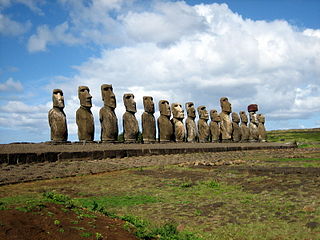
Moai or moʻai are monolithic human figures carved by the Rapa Nui people on Rapa Nui in eastern Polynesia between the years 1250 and 1500. Nearly half are still at Rano Raraku, the main moai quarry, but hundreds were transported from there and set on stone platforms called ahu around the island's perimeter. Almost all moai have overly large heads, which comprise three-eighths the size of the whole statue. They also have no legs. The moai are chiefly the living faces of deified ancestors.

The Rapa Nui are the indigenous Polynesian peoples of Easter Island. The easternmost Polynesian culture, the descendants of the original people of Easter Island make up about 60% of the current Easter Island population and have a significant portion of their population residing in mainland Chile. They speak both the traditional Rapa Nui language and the primary language of Chile, Spanish. At the 2017 census there were 7,750 island inhabitants—almost all living in the village of Hanga Roa on the sheltered west coast.

Rano Raraku is a volcanic crater formed of consolidated volcanic ash, or tuff, and located on the lower slopes of Terevaka in the Rapa Nui National Park on Easter Island in Chile. It was a quarry for about 500 years until the early eighteenth century, and supplied the stone from which about 95% of the island's known monolithic sculptures (moai) were carved. Rano Raraku is a visual record of moai design vocabulary and technological innovation, where 887 moai remain. Rano Raraku is in the World Heritage Site of Rapa Nui National Park and gives its name to one of the seven sections of the park.

Katherine Maria Routledge was an English archaeologist and anthropologist who, in 1914, initiated and carried out much of the first true survey of Easter Island.

Motu Nui is the largest of three islets just south of Easter Island and is the westernmost place in Chile. All three islets have seabirds, but Motu Nui was also an essential location for the Tangata manu cult which was the island religion between the moai era and the Christian era. Motu Nui is the summit of a large volcanic mountain which rises over 2,000 meters from the sea bed. It measures 3.9 hectares in land area and is the largest of the five satellite islets of Easter island. It is one of three islands that is closest to Point Nemo, the place in the ocean that is farthest from land, the other two being Ducie Island, one of the Pitcairn Islands, and Maher Island in Antarctica.

Aku-Aku: the Secret of Easter Island is a 1957 book by Thor Heyerdahl published in Norwegian, Swedish, Danish and Finnish, and in French and English the following year. The book describes the 1955–1956 Norwegian Archaeological Expedition's investigations of Polynesian history and culture at Easter Island, the Austral Islands of Rapa Iti and Raivavae, and the Marquesas Islands of Nuku Hiva and Hiva Oa. Visits to Pitcairn Island, Mangareva and Tahiti are described as well.

The Tangata manu was the winner of a traditional ritual competition on Rapa Nui to collect the first sooty tern egg of the season from the nearby islet of Motu Nui, swim back to Rapa Nui, and climb the sea cliffs of Rano Kau to the clifftop village of Orongo.
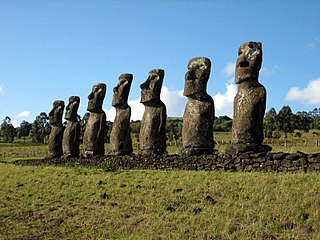
Rapa Nui National Park is a national park and UNESCO World Heritage Site located on Easter Island, Chile. Rapa Nui is the Polynesian name of Easter Island; its Spanish name is Isla de Pascua. The island is located in the southeastern Pacific Ocean, at the southeastern extremity of the Polynesian Triangle. The island was taken over by Chile in 1888. Its fame and World Heritage status arise from the 887 extant stone statues known by the name "moai", whose creation is attributed to the early Rapa Nui people who inhabited the island starting between 300 and 1200 AD. Much of the island has been declared as Rapa Nui National Park which, on 22 March 1996, UNESCO designated a World Heritage Site under cultural criteria (i), (iii), & (v). Rapa Nui National Park is now under the administrative control of the Ma´u Henua Polynesian Indigenous Community, which is the first autonomous institute on the island. The indigenous Rapa Nui people have regained authority over their ancestral lands and are in charge of the management, preservation and protection of their patrimony. On the first of December 2017, the ex-President Michelle Bachelet returned ancestral lands in the form of the Rapa Nui National Park to the indigenous people. For the first time in history, the revenue generated by the National Park is invested in the island and used to conserve the natural heritage.

Makemake in the Rapa Nui mythology of Easter Island is the creator of humanity, the god of fertility and the chief god of the "Tangata manu" or bird-man sect. He appeared to be the local form, or name, of the old Polynesian god Tane. He had no wife.

Orongo is a stone village and ceremonial center at the southwestern tip of Rapa Nui. It consists of a collection of low, sod-covered, windowless, round-walled buildings with even lower doors positioned on the high south-westerly tip of the large volcanic caldera called Rano Kau. Below Orongo on one side a 300-meter barren cliff face drops down to the ocean; on the other, a more gentle but still very steep grassy slope leads down to a freshwater marsh inside the high caldera.
Since the removal from Easter Island in 1868 of the moai now displayed at the British Museum, a total of 12 moai are known to have been removed from Easter Island and to remain overseas. Some of the moai have been further transferred between museums and private collections, for reasons such as the moai's preservation, academic research and for public education. In 2006, one relocated moai was repatriated from the Centro Cultural Recoleta in Argentina after 80 years overseas. In 2022, one moai held in the Chilean National Museum of Natural History in Santiago was returned to the island after 150 years abroad.
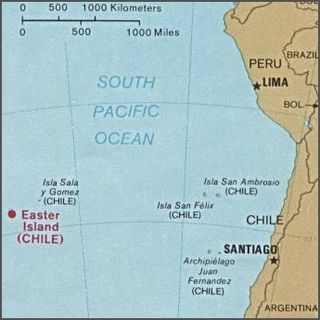
Geologically one of the youngest inhabited territories on Earth, Easter Island, located in the mid-Pacific Ocean, was, for most of its history, one of the most isolated. Its inhabitants, the Rapa Nui, have endured famines, epidemics of disease, civil war, environmental collapse, slave raids, various colonial contacts, and have seen their population crash on more than one occasion. The ensuing cultural legacy has brought the island notoriety out of proportion to the number of its inhabitants.
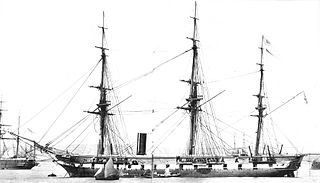
HMS Topaze was a 51-gun Liffey-class wooden screw frigate of the Royal Navy. She was launched on 12 May 1858, at Devonport Dockyard, Plymouth.

The Father Sebastian Englert Anthropological Museum is a museum in the town of Hanga Roa on Rapa Nui in Chilean Polynesia. Named for the Bavarian missionary, Fr. Sebastian Englert, OFM Cap., the museum was founded in 1973 and is dedicated to the conservation of the Rapa Nui cultural patrimony.
Jo Anne Van Tilburg is an American archaeologist best known for her research on the statues of Easter Island. Her primary specialty is rock art.
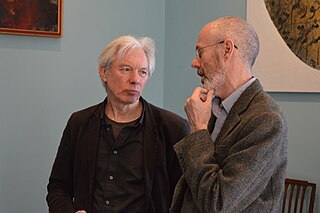
Michael W. Pitts, is an English freelance journalist and archaeologist who specialises in the study of British prehistory. He is the author of several books on the subject, and is the editor of British Archaeology, the publication of the Council for British Archaeology.

Angata, full name María Angata Veri Tahi ʻa Pengo Hare Koho was a Roman Catholic Rapa Nui religious leader from Easter Island during the late 19th and early 20th century. After experiencing a prophetic vision in which God instructed her to retake the land and livestock, she led an unsuccessful rebellion on the island against the Williamson-Balfour Company, intending to create a theocracy centered on Roman Catholicism and Rapa Nui spiritual values.

Juan Tepano Rano ʻa Veri ʻAmo was a Rapa Nui leader of Easter Island. He served as an informant for Euro-American scholars on the culture and history of the island.
Enrique Ika a Tuʻu Hati was elected ‘ariki (king) of Rapa Nui in 1900 and led a failed rebellion. He was one of the last Rapa Nui to claim the traditional kingship in the early 20th-century. However, he is not remembered as the last king instead his predecessor Riro Kāinga is generally regarded as the last king, although neither held much power.






















